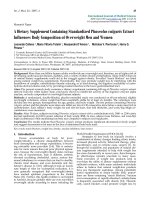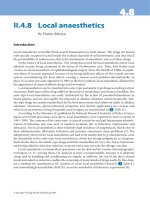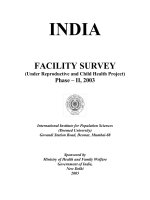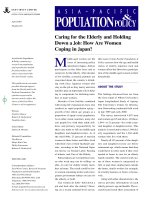40 offseason holding phase
Bạn đang xem bản rút gọn của tài liệu. Xem và tải ngay bản đầy đủ của tài liệu tại đây (445.2 KB, 14 trang )
UNIVERSITY
Offseason
Holding Phase Planning
and Decision Making
Lesson Overview
•
•
•
•
•
•
•
•
•
What is the Holding Phase
Initial Nutrition Set Up
Initial Cardio and Training Set Up
Initial PED Set Up
Decision Making
How much to adjust calories by
When to adjust protein, carbohydrates, and fats
Sample Holding phase monitoring and adjustments
When and how to end the Holding Phase
The Holding Phase
Holding Phase: Transition Point between Push or Fat Loss Phases
Goal: solidify muscle gain and limit bad fat accrual, health restoration
• Nutrition is brought close to maintenance/slight surplus level
• Training is brought down to a recoverable volume
• Cardio/NEAT may slightly increase from a Push Phase or decrease from a Fat Loss Phase
• If Enhanced, PED usage is at minimum levels
• Post push phase a holding phase may last 6-12 weeks
• Post fat loss phase a holding phase may last 1-12 weeks
Tools to Track:
Weekly Pictures
Waist Circumference
3 largest caliper sites
Body weight
Fasting Blood Glucose
Weekly Blood Pressure
Daily Step Count
Gym Performance
Biofeedback
Lets look at each variable set up….
The Holding Phase
Physique expectations and assessment
• Holding new muscle or slight muscle gain
• Limit body fat gain
• PED users might see fullness decrease, weight drop initial from water
• PED users might see slight softer look at same body weight
• More advanced Bbers and PED users are more likely to maintain at
best
• Plan will be adjusted based on subjective and objective data
Nutrition Holding Phase Set Up
Coming off a push phase
• Lower PEDs = lower recovery = lower training ability=slowed muscle
gain and increase fat gain
• Decrease calories to minimize fat gain and hold new tissue and
support connective tissue repair
• Taper calories down over first weeks into Hold Phase
• Changes made should be reactive not proactive
• If PEDs in place to not adjust based on a water weight drop
• Stay in surplus if positive change is still happening
Coming off a fat loss phase
• Coming from high training volume, low food state
• Increase calories to support recovery and fuel training
• Increase based on last week of fat loss. 1lb loss in a week = 500kcal
per day = add in 500kcal per day or 20% kcal increase
Nutrition
Recommendations
Holding
Energy
Protein
Fat
5% above
maintenance
or at
maintenance
kcal
1.0-1.5
g/lb/day
0.30.7g/lb
/day
Carbohydrate
1.0-3.0+
g/lb/day
Training and Cardio/NEAT
Holding Phase Set Up
Resistance Training:
• Move down to a training volume within your recovery capacity
• Only straight sets, remove (drop sets, rest pause sets, beyond failure
sets)
• Another rest day can be added as a simple way to adjust weekly
volume. EX: Pull Push Legs, Off go to: Pull Push Off Legs Off
• Continue normal load rep progressions like any other phase
• Remove any lift causing joint/tissue issues, recovery is focus
Cardio/NEAT:
Slight increase in cardio is acceptable, but large increases can impede
holding new tissue.
Increasing step count is preferred to account for decrease in metabolic
effects of PEDs in order to keep food high
From a fat loss phase taper down to baseline offseason cardio
PEDs Holding Phase Set Up
AAS:
Move down to TRT dosage or Cruise dosage that will hold muscle this will depend on
muscle tissue level and gear needed to achiever that level.
GH:
Move down to 2-3IU as a baseline dosage and improve glucose control
Insulin:
Adjust as needed to tapering off insulin
SERMS/Aromatase Inhibitors
Removed during this phase
Health Support Compounds:
Metformin
ARB/Telmisartan
Caveat:
If coming from a fat loss phase and doing a 1-week deload this holding phase would
not need a decrease in PEDS
Hold Phase Decision Tree
How does the cl ient look visually?
Vi s ually Holding Conditioning
Vi s ually l ook softer a nd
ca l iper sites increasing?
Vi s ually Improving, harder
a nd/or fuller
Tra i ning Performance i ncreasing?
Tra i ning Performance i ncreasing?
Tra i ning Performance i ncreasing?
YES
No change
to diet or
NO
Consider
training volume
reduction
Increase
calories to
allow for
<0.25% wt
increase/wk
YES
Decrease
calories 5%
or increase
NEAT/cardio
NO
Consider
training volume
reduction
STEP 1
Increase
calories 510%
Increase
Protein and
decrease
carbohydrate
or fat
STEP 2
Decrease
calories 5% or
increase
NEAT/cardio
YES
Increase
calorie 5% if
not at 0.25%
wt
increase/wk
NO
Consider
training
volume
reduction
Adjusting Calories and Macros
General Rules:
Make one change at a time
Holding phase look for maintenance or <0.25% weight increase per
week
Changes made should be reactive not proactive after initial set up
Maintaining performance is paramount so keep calories high enough
and some body fat gain can be allowed
If weight is increasing and visually softer increase protein to 1.5g/lb
and decrease carbohydrates in turn as a first action
Option 1 : If weight is still increasing and getting softer decrease
calories 10%
Option 2: If weight is still increasing and getting softer and cardio is
low you can increase cardio by 10min per session.
Assess next week and adjust accordingly
Which macros to adjust?
Adjusting Protein
When should we increase protein?
Weight change is increasing gaining too much body fat, lower carbs
and increase protein.
Hunger is high, increase protein
When should we decrease protein?
Hunger typically is lower in a holding phase (less PEDs, less training)
Hold protein high for improved partitioning look to adjust food sources
and fats first
Protein should be within target of 1-1.5g/lb of Body weight, so usually
last macro to adjust.
Adjusting Carbohydrates and Fats
Into a holding phase decrease in training volume means less
carbohydrates for fuel and PEDs lowered will shift partitioning to fat
gain.
Lower carbs as a first strategy caveat is don’t go below 1g/lb of body
weight and if going lower monitor gym performance closely.
This may also aid in blood glucose control with fats higher keep stable
blood glucose
If carbohydrates are too low, adjust fats down accordingly
From a push phase both carbs and fats might be high, and a reduction
can be made from ½ fat ½ carbs. You can let the athlete help dictate
this change based on preference.
From a fat loss phase, push rules apply and make the initial increase
come from carbohydrates.
Hypothetical Male Bodybuilder Holding Phase Progression
weight
caliper
arm
quad
waist
BP
BG
rate of gain
Calories
Macros
Cardio
NEAT
Training
PEDS
pics
wk 14 Push
wk 1 Holding
wk 2
wk 3
wk 4
227
227.5
225
225
225.4
10,10,9
10,10,9
10,10,9
10,11,10
10,12,12
18.4
18.4
18.3
18.3
18.3
28.5
28.5
28.4
28.4
28.4
34.2
34.2
34.2
34.4
34.4
115/72
114/75
110/70
110/72
112/80
83
80
81
82
85
0.35
0.22
-1.1
0
0.17
3430
3430
3430
3370
3270
400/300/70 400/300/70
400/300/70 350/335/70
325/335/70
3x20
3x20
3x20
3x20
3x20
5200
5500
5500
5500
5500
PPALO
PPoffALoff
PPoffALoff
PPoffALoff
PPoffALoff
test 300; Primo test 200; GH 2IU, test 200; GH test 200; GH 2IU, test 200; GH
300; NPP 200; Metformin 500,
2IU,
Metformin 500, 2IU,
GH 4IU;
telmisartan 20
Metformin
telmisartan 20
Metformin
Metformin 500;
500,
500,
telmi 20
telmisartan 20
telmisartan
20
fuller look
look holding
increase
deload
no change
post deload
water drop
from PED,
tighter
Diet/hunger
Stregth
PRS
Changes
10
NONE
hunger
holding
increase
10
Increase rest day
9
softer in pics
softer
hunger same
maintain
hunger
decrease
maintain
9
8
Increase protein,
hold diet same decrease carbs 25g carb pull
Ending the Holding Phase
Time to end the Holding Phase?
Health markers ideal?
All joint connective tissue issues resolved?
Mentally feel fresh?
Life allows for more sleep less stress moving into fat loss or push phase?
Body weight and body fat stable?
Training:
Last week of holding phase run a deload
A holding phase maybe a serve as a deload if coming off a fat loss phase
Nutrition
Hold diet the same based on body comp for last week
Cardio
Can be held constant at this time
PEDS
Last week of cruise dosages
Lab work
Labs drawn at end of holding phase prior to next push up or fat loss phase
Summary
Holding phase are used to solidify new muscle gain, limit fat gain, drop
fatigue, and restore health markers
The decision process in adjusting during a holding phase for naturals
can be based more on body weight. For enhanced watch visuals
closely.
Upmost importance is upholding training performance to hold new
tissue gains.
Next let's move to setting up and progressing in a Fat Loss Phase or
Minicut.









